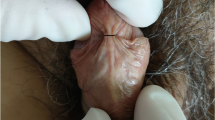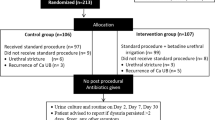Abstract
Objectives: Preputial bacterial colonisation was investigated in preschool and primary school children with and without phimosis before the circumcision procedure. Method: The study group consisted of 32 boys admitted to our clinic consecutively between June 2003 and September 2003 for circumcision. The indication for surgery was religious belief in all patients. Immediately before the procedure, a swab was swept circumferentially once around the surface of the glans starting just proximal to the urethral meatus. In case of phimosis the same procedure was performed after complete retraction of the foreskin avoiding external contamination. The cultures were repeated in all patients after cleansing the glans and nearby preputium with polyvidon-iodine solution. Results: The mean age of the patients’ was 6 (4–12) years. All 5 (100%) patients with phimosis had clinically significant (≥100,000 cfu/ml) uropathogenic bacterial colonisation. In 27 (84.3%) patients without phimosis culture reports revealed the absence of growth in 8 (29.6%) patients while 3 (11.1%) had Diphteroids and 1 (3.7%) had α-haemolytic Streptococci isolated from their preputial swabs which were accepted as harmless skin commensals. The rest of the boys (55.5%) had uropathogenic species in their preputium and all except 2 (7.4%) cases had counts exceeding 100,000 cfu/ml. The overall rates for individual species including any count were found as E. coli 3.1%, Klebsiella 18.8%, coagulase-negative Staphylococci12.5% and Enterococcus 43.8%. Cleansing of perimeatal and periurethral region with 10% polyvidon-iodine solution markedly decreased the bacterial count in 80% of the patients with phimosis. Including eight patients with no growth before cleansing 88.9% of the patients in the non-phimosis group were free of preputial bacteria after cleansing with iodine solution. Conclusion: Significant preputial colonisation with uropathogens might still be present in preschool and primary school children.
Similar content being viewed by others
References
CM Ginsberg GH Mc Cracken SuffixJr. (1982) ArticleTitleUrinary tract infections in young infants Pediatrics 69 409–412 Occurrence Handle7070887
TE Wiswell FR Smith JW. Bass (1985) ArticleTitleDecreased incidence of urinary tract infections in circumcised male infants Pediatrics 75 901–903 Occurrence Handle3991278
TE Wiswell JD. Roscelli (1986) ArticleTitleCorroborative evidence for the decreased incidence of urinary tract infections in circumcised male infants Pediatrics 78 96–99 Occurrence Handle3725505
TE Wiswell RW Enzenauer ME Holton et al. (1987) ArticleTitleDeclining frequency of circumcision: implications for changes in the absolute incidence and male to female sex ratio of urinary tract infections in early infancy Pediatrics 79 338–342 Occurrence Handle3822633
JC Craig JF Knight P Sureshkumar E Mantz LP. Roy (1996) ArticleTitleEffects of circumcision on incidence of urinary tract infection in preschool boys J Pediatr 128 23–27 Occurrence Handle8551417
T To M Agha PT Dick W. Feldman (1998) ArticleTitleCohort study on circumcision of newborn boys and subsequent risk of urinary tract infection Lancet 352 1813–1816 Occurrence Handle10.1016/S0140-6736(98)02392-7 Occurrence Handle9851381
S Cascio E Colhoun P. Puri (2001) ArticleTitleBacterial colonization of the prepuce in boys with vesicoureteral reflux who receive antibiotic prophylaxis J Pediatr 139 IssueID1 160–162 Occurrence Handle10.1067/mpd.2001.115017 Occurrence Handle11445813
EN Fussell MB Kaack R Cherry JA. Roberts (1988) ArticleTitleAdherence of bacteria to human foreskins J Urol 140 997–1001 Occurrence Handle2902235
TE Wiswell GM Miller HM Gelston SuffixJr SR Jones AF. Clemmings (1988) ArticleTitleEffect of circumcision status on periurethral bacterial flora during the first year of life J Pediatr 113 442–446 Occurrence Handle3411387
I Bollgren J. Winberg (1976) ArticleTitleThe periurethral aerobic bacterial flora in healthy boys and girls Acta Pediatr Scand 65 74–80
SS Wijesinha BL Atkins NE Dudley PKH. Tam (1998) ArticleTitleDoes circumcision alter the periurethral bacterial flora? Pediatr Surg Int 13 146–148 Occurrence Handle10.1007/s003830050270 Occurrence Handle9563029
RJ Hallett L Pead R. Maskell (1976) ArticleTitleUrinary infection in boys: a three year prospective study Lancet 2 IssueID7995 1107–1110 Occurrence Handle10.1016/S0140-6736(76)91087-4 Occurrence Handle62948
TA. Schlager (2001) ArticleTitleUrinary tract infections in children younger than 5 years of age: epidemiology, diagnosis, treatment, outcomes and prevention Paediatr Drugs 3 IssueID3 219–227 Occurrence Handle11310718
R Maskell L Pead RJ. Hallett (1975) ArticleTitleUrinary pathogens in the male Br J Urol 47 IssueID6 691–694 Occurrence Handle817760
Roberts JA. Circumcision and urinary tract infections. Presented at the annual meeting of the American Academy of Pediatrics, New Orleans, USA: Nov 3, 1987.
A. Ronald (2003) ArticleTitleThe etiology of urinary tract infections: traditional and emerging pathogens Dis Mon 49 IssueID2 71–82 Occurrence Handle10.1016/S0011-5029(03)90001-0 Occurrence Handle12601338
J Glennon PJ Ryan CT Keane JP. Rees (1988) ArticleTitleCircumcision and periurethral carriage of Proteus Mirabilis in boys Arch Dis Child 63 556–557 Occurrence Handle3291784
B Guirguitzova D Chankova B Zozikov N. Minkov (1992) ArticleTitleEnterococci as uropathogens Frequency of isolation and sensitivity to antibacterial agents. Ann Urol 32 IssueID1 15–19
RC Moellering SuffixJr. (1998) ArticleTitleVancomycin-resistant enterococci Clin Infect Dis 26 IssueID5 1196–1199 Occurrence Handle9597252
N Kumari A Rai CP Jaiswal A Xess SK. Shahi (2001) ArticleTitleCoagulase negative staphylococci as causative agents of urinary tract infections-prevalence and resistance status in IGIMS, Patna Indian J Pathol Microbiol 44 IssueID4 415–419 Occurrence Handle12035353
K Abrahamsson S Hansson U Jodal K. Lincoln (1993) ArticleTitleStaphylococcus saprophyticus urinary tract infections in children Eur J Pediatr 152 IssueID1 69–71 Occurrence Handle8444210
DE Hall JA. Snitzer (1994) ArticleTitleStaphylococcus epidermidis as a cause of urinary tract infections in children J Pediatr 124 IssueID3 437–438 Occurrence Handle8120716
Author information
Authors and Affiliations
Corresponding author
Rights and permissions
About this article
Cite this article
Tokgöz, H., Polat, F., Tan, M.Ö. et al. Preputial Bacterial Colonisation in Preschool and Primary School Children. Int Urol Nephrol 37, 101–105 (2005). https://doi.org/10.1007/s11255-004-4700-x
Issue Date:
DOI: https://doi.org/10.1007/s11255-004-4700-x




